Like New 1984 Seville with only 9,700 miles from new.
- Price: Ask a price!
- Condition: Used
- Item location: Boulder, Colorado, United States
- Make: Cadillac
- Model: Seville
- SubModel: Touring Suspension
- Type: Sedan
- Trim: Touring Suspension
- Year: 1984
- Mileage: 9,700
- VIN: 1G6AS6985EE820744
- Color: Blue
- Engine size: 4.1 Liter Gasoline
- Number of cylinders: 8
- Power options: Air Conditioning, Cruise Control, Power Locks, Power Windows, Power Seats
- Fuel: Gasoline
- Transmission: Automatic
- Drive type: FWD
- Interior color: Blue
- Options: Leather Seats, CD Player
- Vehicle Title: Clear
Cadillac Seville 1984 Description
You are bidding on a 1984 Cadillac Seville with less than 9,700 miles from new. It is in beautiful original condition throughout.I have made the following improvements to the car: 1. Replaced the original catalytic converter with a more modern high-flow converter -- that increased the performance of the car substantially. 2. Changed all the fluids and filters in the car. 3. Replaced the spark plugs with new iridium plugs. 4. Replaced the driver's sun visor (which would not stay up) with a remanufactured one from Cadillac King. 5. Replaced the shock absorbers with a slightly heavier shock that improves handling. 6. Installed four new Vogue tires. 7. The original radio was missing from the car when I bought it. I installed a new Retro Sound unit which plays AM, M, Ds, SBs and has BlueTooth so you can listen to Pandora through your phone.
The car is really exceptional and turns heads wherever I drive it. It is the most comfortable car I have owned in a long-time.
Why am I selling it? I have lost my storage space and have to get down to just three vehicles, o my beautiful Cadillac Seville needs a new home.
If you aren't familiar with these really exceptional cars, ollowing are excerpts from a story on these cars that ran in Hemmings Motor News in December of 2010:
Bustleback Beauty - Cadillac SevilleBeneath the Seville's controversial styling lies what was arguably GM's most advanced chassis to date.
Over the past decade and a half, he whole notion of "heritage" styling has come to the fore. Plymouth Prowler and Chevy SSR, hrysler PT Cruiser and Ford Thunderbird. The Mustang and current Challenger are as close as they can be, isually, o the decades-old originals without violating DOT scripture.
Yet the ideais hardly original--which is, ou might gather, art of the point. GM has been a proponent of yesterday since at least the 1970s, hen Bill Mitchell embraced his love for the elegance of the pre-war era. The boattail Buick Riviera of 1971-'73 had a tail treatment reminiscent of any number of custom-crafted, porting Thirties automobiles. Any of the 1973 GM A-bodies, ncluding the A-Special personal luxury coupes, ad bold, pright grilles, ront fenders that appeared to be separate from the hoods and tails that ended in points until bumper regulations forbade it. Whitewall tires and wire hubcaps, hen available, dded to the retro flair. Shoot, he original Seville was almost called La Salle.So in some ways, he new-old 1980 Cadillac Seville shouldn't have been the shock that it apparently was. Forward of the C-pillar, t seemed a trim, ithe vision of a Cadillac in the 1980s, eaturing a slicked-back windscreen and square-ish, olid lines. But the tail was morphed into a pastiche of vintage high-end English limousine styling; comparisons to a Hooper-bodied 1954 Rolls-Royce and any number of Daimlers were lobbed about. The style has since been shorthanded as the "bustleback" treatment among proponents and detractors alike, nd while you'd think that the abbreviated trunklid would cut into the Seville's trunk space, rochures insisted that the new car had "more usable space" (14.5 cubic feet) than the outgoing Nova-based Seville.But hidden beneath that retro styling was one of GM's most technologically savvy chassis ever. It was front-wheel drive, f course, by-product of sharing parts with the new-for-1979 Eldorado. But four-wheel independent suspension wasn't something that GM messed with much beyond the Corvette; torsion bars replaced coil springs in front, resumably to allow the transaxle's halfshafts greater leeway in their movement, hile anti-roll bars were fitted front and rear. Electronic suspension leveling was part of the package from the outset, s were four-wheel disc brakes. Save for the front-wheel drive aspects, he chassis's equipment list reads like that of a German sedan that would have cost 50 percent more.The engine in our 1985-model driveReport car, adillac's HT4100, as installed in every car Cadillac built (except for the Cimarron) starting in the autumn of 1981; the 6.0-liter V-8-6-4 had been such a disaster that the switch was widely embraced. The initials HT stood for High Technology, espite much of the technology used on it having been innovated at other times. It incorporated a die-cast, eep-skirt, pen-deck aluminum block that was topped with cast-iron cylinder heads, ut unlike the Chevrolet Vega aluminum engine, his time GM was smart enough to install wet-iron sleeves in the cylinders. While the cylinder heads were indeed cast iron, uch of the intake ports were designed into the aluminum intake manifold; this enhanced the compactness of the cylinder heads themselves, inimizing the use of heavy cast iron. Even the rocker-arm supports were die-cast aluminum. Friction was reduced with low-tension piston rings, pecific bearing clearances, nd a specially designed low-drag aluminum water pump. A digitally metered twin-throat throttle-body fuel injection system corralled the air/fuel mixture into the intake manifold, ut this had been around since the new front-drive Seville launched in 1980.The resulting engine weighed just 420 pounds, whopping 210 pounds less than the outgoing 6.0L V-8, nd was good for at least two miles per gallon more across the board. There was a penalty, owever: The HT4100 was rated at just 135 horsepower, nd with just 200-lbs.ft. of torque, t was down a whopping 70-lbs.ft. from the previous V-8.Seville's sales numbers did something of a reverse bell-curve during the bustleback years: roughly 39,000 units per year during 1980-'85, ith a low point of just 19,998 units for the 1982 model year; total six-year production was 198,155. So once again, eville bucks the trend. But what it looks like and how it sold doesn't matter a bit when you're behind the wheel. Let's take this one for a spin.The door opening is fairly narrow for larger folks, ut the leather-wrapped tilt wheel helps enormously when you're getting in. Head and shoulder room are, urprisingly, n the league of the previous Seville; the styling pretensions of the bustleback model lead you to believe it would be bigger inside, ut it's not. The completely flat floorpan does help, owever. The busy driver's armrest controls all manner of functions, ncluding locks, indows, irrors and the pilot's chair; they all work, nd they all exude a high level of quality.Slide the gold-plated key into the ignition. One click, nd instead of the normal nasty warning buzzer you get on lesser cars, here's instead a faint department-store elevator chime from somewhere in the interior. A second click, nd the V-8 quickly fires up, lmost silently. Here's the shocker: At idle, ou could feel the engine's vibrations creep into your seat. With traffic whistling by just a tenth of a mile away, his, nd the illuminated instrument cluster, re the only indications that the Seville is running.Shift into drive--with your fingertips, s your right hand need never move off the steering wheel to select gears. Move out into traffic, it the gas pedal, nd the HT4100 engine quickly feels outmatched--stabbing the throttle or smoothly rolling into it doesn't matter at all. Cadillac's little V-8 is creamy smooth at all revs, ut it starts making urgent noises a grand before redline; the factory-provided 135 fuel-injected horsepower (or, ore to the point, 00-lbs.ft. of torque) labors to haul two tons, ith passengers, p to cruising speed. The effortless, loating-on-clouds torque of the big 500-cu.in. Cadillac V-8s of yore has left the building.In some respects, his makes sense: The Seville was a new-sized Cadillac for a new generation, nd it demanded new parameters. Yet you don't get the sense that the car is heavy, nly that the engine needs a little more oomph behind it. Once you're at speed, hough, he actual driving experience isn't as labored as the acceleration would lead you to believe. Cruising is effortless--there's simply some slight wind noise at the B-pillar to take you out of the luxury-car mood. Speed bumps are treated like children of days gone by--seen and not heard--while the super-light steering makes for easy cornering and handling around town. The flat, lush, utton-tuck seats actually keep you in place very well while the car rolls ever so slightly around the bends. There really isn't enough room for you to slosh around.What the four-wheel disc brake system lacks in pedal feel, t more than makes up for in actual stopping ability; the car stops quickly and effectively, ithout any drama. And if the Seville owners are to be believed, 20-22 MPG highway average is regularly obtained. Suddenly, he benefits of 135hp, transaxle with overdrive and a smaller front end to the wind start to prove themselves in a very positive way.We find that the second-generation Seville is a car of paradoxes. That taut chassis is more tuned for boulevard cruising rather than twisting back roads, ut, hen again, hat's not what Cadillacs were made for, or how their owners intended to drive them. It's got an all-new V-8 engine, yped as high-tech, ut made using mostly proven methods and materials--a type of engine that was treated to a deathwatch from its birth. It used a combination of aluminum block and cast-iron cylinder heads that, ot a dozen years earlier, ad brought many headaches to the engineering staff. It's outfitted with a traditional interior with leather and faux wood, ompeting with high-tech digital readouts. It sold better at the ends of its life than the useful middle. And, f course, t sported that decidedly yesteryear tail treatment on one of GM's most advanced chassis ever. These contradictory details remain a head scratcher to some, ut they add up to a car that is most assuredly under-rated as one of the most technologically forward-thinking machines Detroit built at the dawn of the 1980s.Owner's View
We're actually both Mercedes fanatics...but we were both in college in the '80s, e both love the '80s, nd when we were growing up, f you had this car in your driveway, ou'd really made it. It's one of those we always dreamed of having."We actually bought this car one Sunday night after a couple of bottles of wine; the photos looked great, ut when it arrived, e saw that it had the typical water-based GM paint crackle all over it. We kept it for a year, ent it to our upholstery guy, ho redid the interior, hen took it to the body shop for the paint. They stripped it down to bare metal for us."No one would ever restore one--we're some of the few screwballs who would. And you can't believe the looks we get! Whenever we're out, e get stories from people--'Oh, y grandpa had one,' or 'Mom had one.'"It's such a fun car to have...my entire staff is dying to ride in that car! They couldn't believe I have it, nd they're begging me to go for a drive."-- Dr. David Kalemkarian and Aaron Thomas May1985 Cadillac Seville
SPECIFICATIONSPRICE
Base price -- $23,729ENGINE
Type -- OHV V-8, luminum block with cast-iron cylinder heads
Displacement -- 249 cubic inches
Bore x Stroke -- 3.46 x 3.31 inches
Compression ratio -- 8.5:1
Horsepower @ RPM -- 135 @ 4400
Torque @ RPM -- 200-lbs.ft. @ 2200
Valvetrain -- Hydraulic valve lifters
Main bearings -- 5
Fuel system -- GM throttle-body fuel injection
Lubrication system -- Pressure, ear-type pump
Electrical system -- 12-volt
Exhaust system -- Single exhaustTRANSMISSION
Type GM Turbo Hydra-Matic 325 4L four-speed automatic transaxle with overdrive
Ratios:
1st 2.74:1
2nd 1.57:1
3rd 1.00:1
4th 0.67:1
Reverse 2.07:1
Final Drive Ratio 3.15:1STEERING
Type -- Variable-ratio recirculating ball, ower assist
Turns, ock-to-lock -- 2.9
Ratio -- 13:1
Turning circle -- 38.4 feetBRAKES
Type -- Hydraulic, our-wheel disc, ower-assist
Front -- 10.4-inch vented rotor
Rear -- 10.4-inch vented rotorCHASSIS & BODY
Construction Full-length frame with rubber-isolated body
Body style Four-door sedan
Layout Front engine, ront-wheel driveSUSPENSION
Front -- Independent; unequal-length control arms; torsion bars; telescoping shock absorbers; anti-roll bar
Rear -- Independent; semi-trailing arms, oil springs, utomatic load-leveling shock absorbers, nti-roll barWHEELS & TIRES
Wheels -- Steel, ive-lug, ith hubcap
Front -- 15x6
Rear -- 15x6
Tires -- GM-specified steel belted radial
Front -- 205/75R15
Rear -- 205/75R15WEIGHTS & MEASURES
Wheelbase -- 114 inches
Overall length -- 205.5 inches
Overall width -- 70.9 inches
Overall height -- 54.3 inches
Front track -- 59.3 inches
Rear track -- 60.6 inches
Shipping weight -- 3,688 poundsCAPACITIES
Crankcase -- 5 quarts
Cooling system -- 12 quarts
Fuel tank -- 20.3 gallons
Transmission -- 6 quartsCALCULATED DATA
Bhp per cu.in. -- 0.542
Weight per bhp -- 27.32 pounds
Weight per cu.in. -- 14.81 pounds
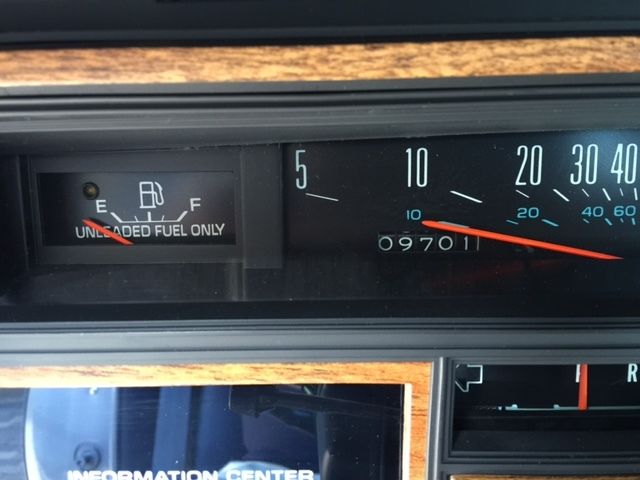
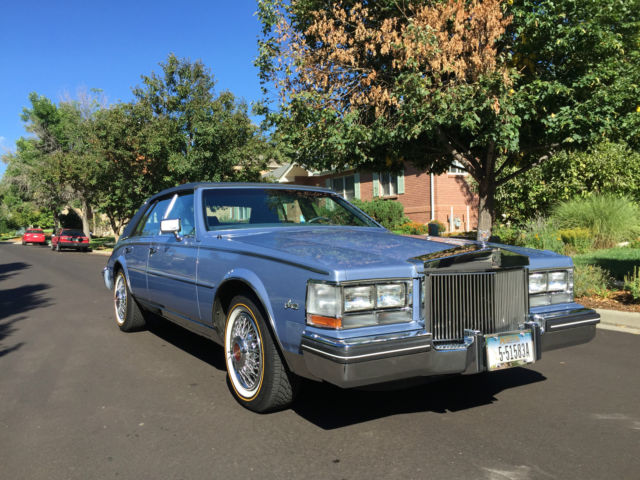
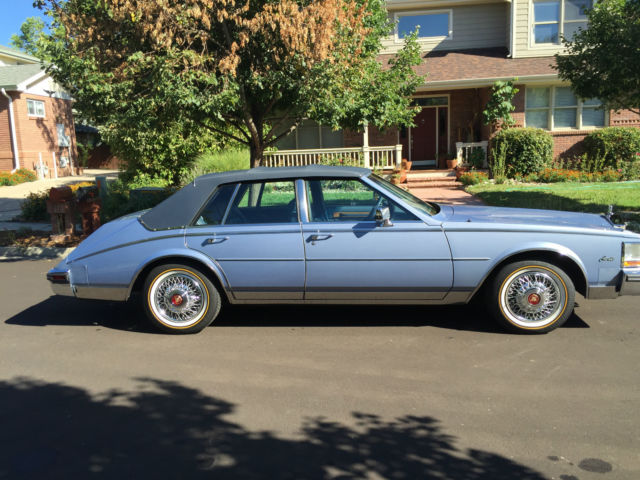
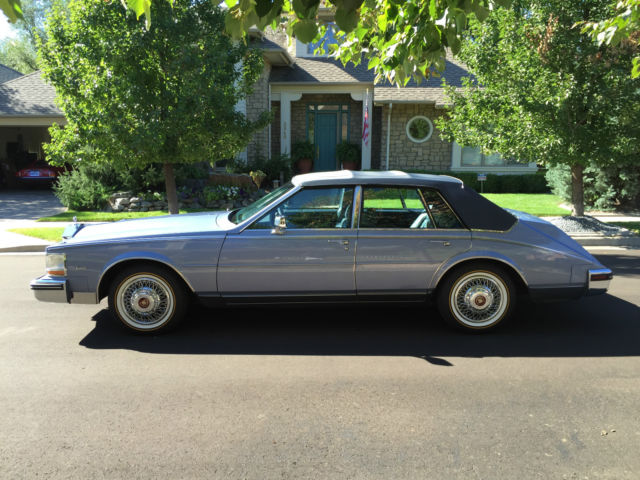
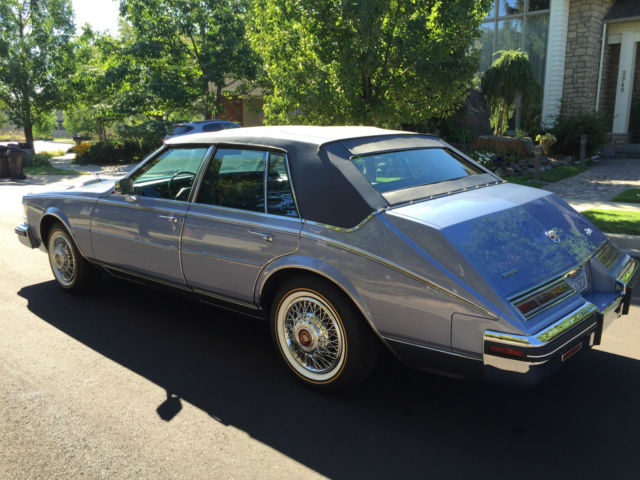
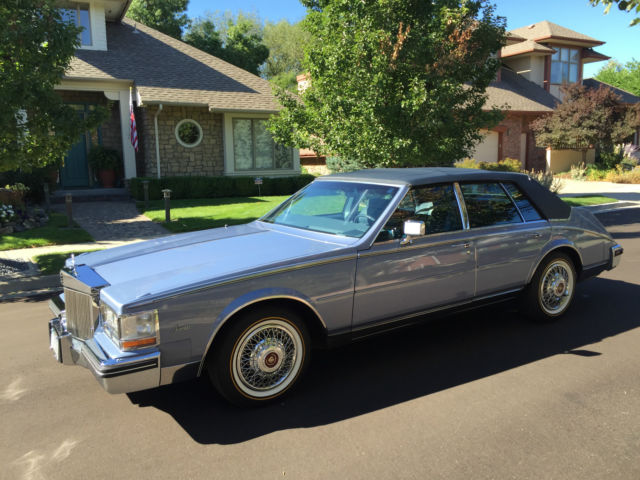
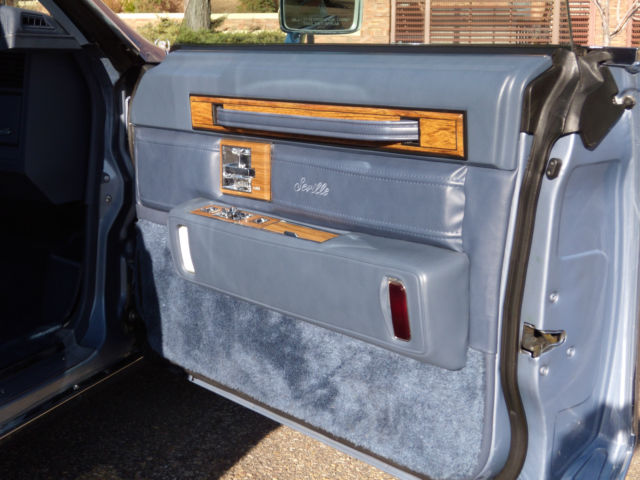
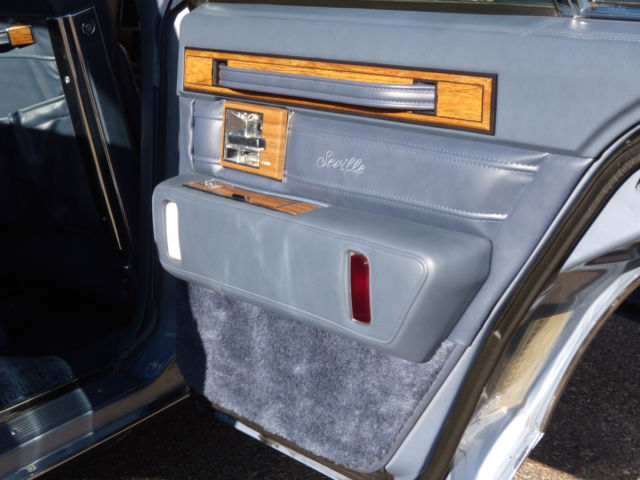
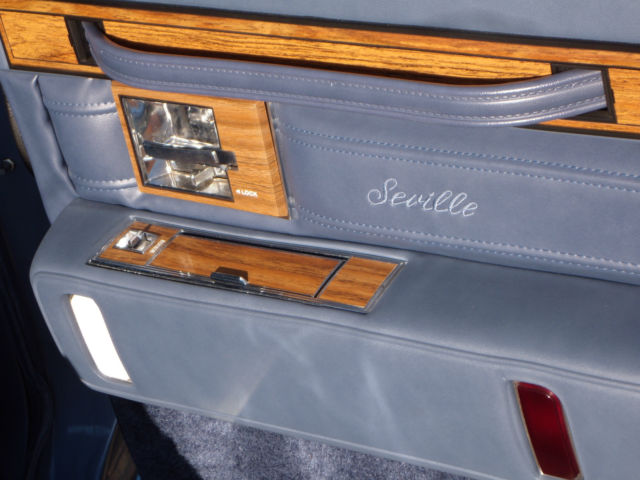
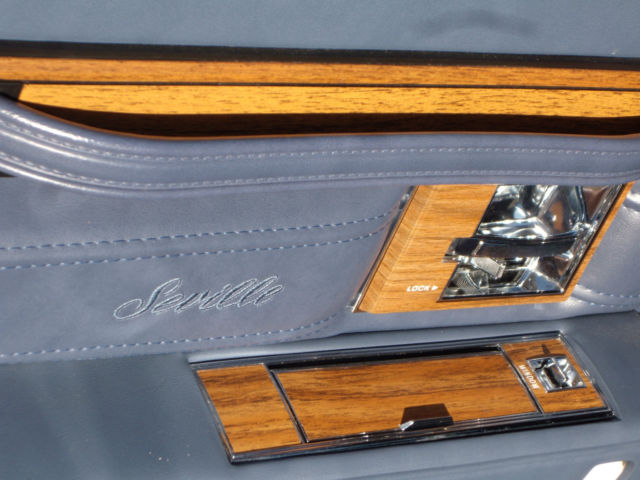
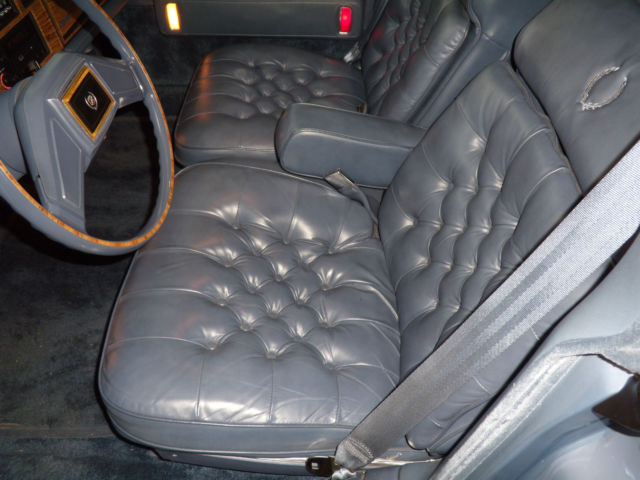
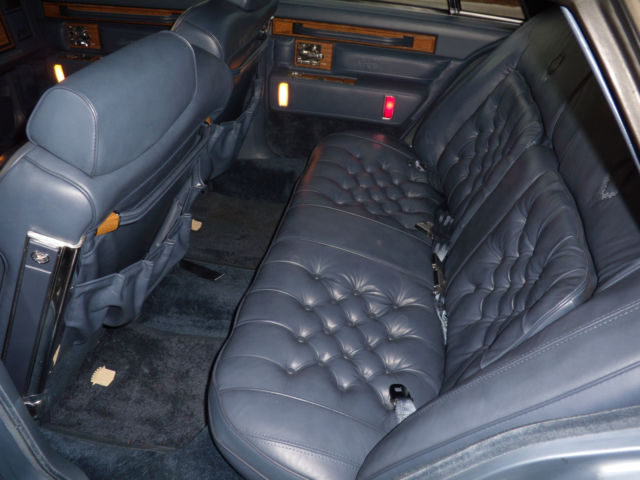
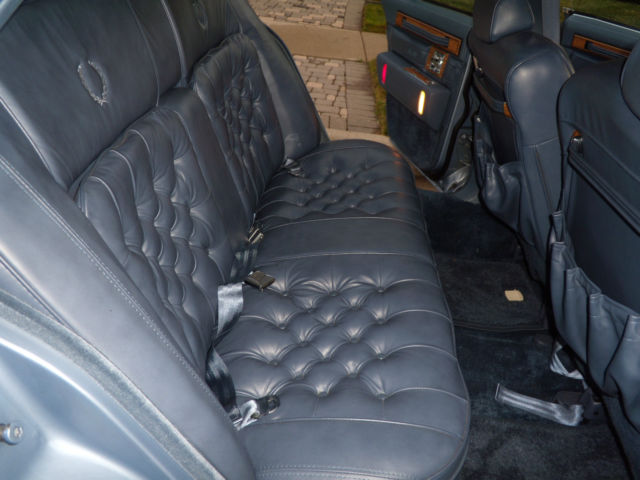
 1984 CADILLAC SEVILLE ONLY 26,442 ORIGINAL MILES ABSOLUTELY LIKE NEW
1984 CADILLAC SEVILLE ONLY 26,442 ORIGINAL MILES ABSOLUTELY LIKE NEW
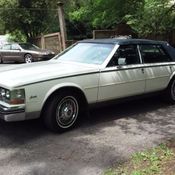 Cadillac Seville 1984, excellent original condition, low miles
Cadillac Seville 1984, excellent original condition, low miles
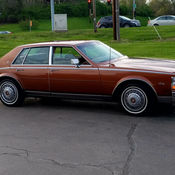 1984 cadillac seville 52000 miles with working AC and velour seats
1984 cadillac seville 52000 miles with working AC and velour seats
 1984 Cadillac Seville Roadster Sedan Blue Low Miles Nice L@@K!!!!
1984 Cadillac Seville Roadster Sedan Blue Low Miles Nice L@@K!!!!
 Classic 1984 Cadillac Seville
Classic 1984 Cadillac Seville
 1984 CADILLAC SEVILLE ONE OWNER
1984 CADILLAC SEVILLE ONE OWNER
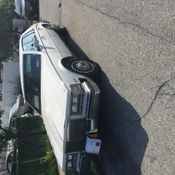 1984 Cadillac Seville 4 door sedan
1984 Cadillac Seville 4 door sedan